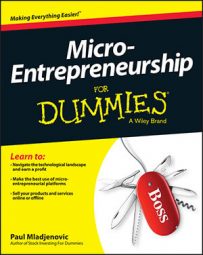PPC or pay per click is an advertising model where you, the advertiser, pay only when your Internet ad is clicked, and prospects jump to your micro-entrepreneurial website or sales page. Before creating your ad, you should determine exactly what you want to promote: a product, service, or brand.
You want to be as specific as you can about what you’re offering because the deeper you target your niche, the less money you will spend on your ad and the more targeted your customers will be — all in all, a win-win approach!
As you begin to create your ad, ask yourself these questions:
-
Who will buy your product or service?
-
Where are these customers located?
-
What words do they use to describe your product or service?
The answers to these questions can help you better target your prospective buyers in terms of what and where they will buy along with what potential keywords they may use. If you use tools such as iSpionage, SpyFu, Wordtracker, Google’s keyword tool, and Google’s traffic estimator to help you pinpoint both the words and the buyers, you can have any easier time generating responses and subsequent sales.
After you have a better idea about what you want your ad to say and how you want it to look, you can choose from two popular types of ads to promote your business through PPC.
Text PPC ads for your micro-entrepreneurial business
Text ads are very popular for PPC; they’re used on sites like Google, Facebook, LinkedIn, and Bing. Text ads usually have a bold headline with a short snippet of text. The text ad is clickable and leads to your web page or sales page. The best part about text ads is that you select where you would like them to appear.
When you’re creating a PPC text ad, keep these important points in mind:
-
Title: The title, also known as the heading, is usually bold blue. It’s usually the first thing potential customers will see, so you want to create an attention-grabbing, thoughtful targeted title with words like “SALE” or numbers like “50 percent off”.
-
Simplicity: Don’t overcomplicate your ad; keep it simple because you’ll have a limit to how many characters you use (a 25-character limit is typical).
-
Description: The two description lines are limited to 35 characters each. Use this space to insert at least two of your keywords because it will help your ad establish relevance and help lower your bidding.
-
Telephone contact: You can also add your phone number to your text ad. Doing so works especially well if you’re targeting mobile devices because the number appears as a click-to-call feature (readers can click directly on the phone number from their smartphone, and their phone makes the call) on your ad.
Some advertisers allow you to include your phone number to your ad only if you pay a premium. Google reports that AdWords advertisers have experienced a 6 to 8 percent average increase in click-through rates, simply by activating call extensions.
Banner PPC ads for your micro-entrepreneurial business
Banner ads are great for building your brand. Banner advertising is very cheap, whether you select pay per click or CPM. You can have your banner showing on hundreds of websites for just a few dollars every month.
-
Clicks: This method works the same as the text ad; see the preceding section.
-
Cost per Millie (CPM): CPM is measured by 1000 impressions; each time your ad is seen 1,000 times, you are charged. Some CPM rates are as low as 15 cents per 1000 impressions.
Keep these pointers in mind when creating a banner ad:
-
Size: When creating a banner ad, you want to create multiple sizes to be sure it fits into all websites. Choose from the most popular banner ad sizes:
-
Medium rectangle 300 × 250
-
Square popup 250 × 250 (shown here)
-
Leaderboard banner 728 × 90
-
Full banner 428×60
-
Wide skyscraper 160 × 600
![[Credit: Illustration courtesy of William Donato]](https://www.dummies.com/wp-content/uploads/381698.image0.jpg) Credit: Illustration courtesy of William Donato
Credit: Illustration courtesy of William Donato
-
-
File size and formats: As a general rule, try to keep your file sizes smaller than 50KB and save your file as .png, .jpg, or .gif , which are the most popular image formats. These standards can ensure your banner ad gets approved.
-
Research design: Examine what hot item or hot topic you can display in your banner ad. Maybe you can visually express an idea that grabs attention.
For example, if your micro-business sells balloons, for instance, maybe you can have a banner ad with unusual shaped balloons to grab interest. The key is to grab interest visually from targeted prospects.
Another popular design option is to create a flash banner. A flash banner has moving images. They grab more attention.
-
Follow-through: Great banners should lead to great offers and great websites. When people click your ad, make sure your offer or website is consistent in both style and content. Track your banner’s performance and tweak until more and more of your clicks turn into profitable results.
-
Remarketing: (or re-targeting prior prospects) is a strategy in which you re-market to people who have previously visited your site, and encourage them to come back and buy. Remarketing is a bit tricky to set-up, so you might need some help. Try Google’s remarketing page, Remarketing, Anerican Marketing Association, and Web Marketing Today.

